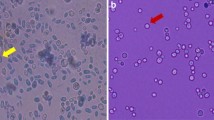Abstract
In order to determine the potential for cross-transmission ofCandida spp. between health-care workers and patients, the survival of clinical isolates of five species ofCandida on the palms of human volunteers was tested. One hundred µl of a McFarland 1.0 density suspension (5×105 cfu) from an overnight culture ofCandida albicans, Candida krusei, Candida parapsilosis, Candida tropicalis andCandida glabrata was used as inoculum. The degree of hydrophobicity of the differentCandida species was also tested and did not influence the survival. The half-lives were brief, being 9.5, 12.4, 7.4, 12.8, 9.6 min forCandida albicans, Candida krusei, Candida glabrata, Candida parapsilosis, andCandida tropicalis, respectively, but at 45 min 2.6 × 103 to 3 × 104 organisms remained on the hands. Survival ofCandida albicans for as long as 24 h on inanimate surfaces was observed. Transmission from one hand to a second hand occurred in 69 % of the experiments and from the first to a third hand in 38 %. Transmission to and from inanimate surfaces was successful in most of the experiments (90 %). This experimental model aids in the biological study ofCandida spp. and suggests some of the potential mechanisms of transmission.
Similar content being viewed by others
References
Fraser DW, Ward JI, Ajello L, Plikaytis BD: Aspergillosis and other systemic mycoses: the growing problem. Journal of the American Medical Association 1979, 242: 1631–1635.
Centers for Disease Control and Prevention: Nosocomial infection Surveillance, 1983. Centers for Disease Control, Atlanta, 1984, Surveillance Summaries 33, No. 255.
Morrison AJ, Freer CV, Searcy MA, Landry SM, Wenzel RP: Nosocomial bloodstream infections: secular trends in a statewide surveillance program in Virginia. Infection Control 1986, 7: 550–553.
Wenzel RP, Pfaller MA:Candida species: emerging hospital bloodstream pathogens. Infection Control and Hospital Epidemiology 1991, 12: 523–524.
Gold JWM: Opportunistic fungal infections in patients with neoplastic disease. American Journal of Medicine 1984, 76: 458–463.
Bodey GP: Candidiasis in cancer patients. American Journal of Medicine 1984, 77, Supplement 4D: 13–19.
Sobel JD:Candida infections in the intensive care unit. Critical Care Clinics 1988, 4: 325–344.
Wey SB, Mori M, Pfaller MA, Woolson RF, Wenzel RP: Hospital-acquired candidemia: the attributable mortality and excess length of stay. Archives of Internal Medicine 1988, 148: 2642–2645.
Odds FG: Candida and candidosis. Bailliere Tindall, London 1988, p. 68–92.
Krause W, Matheis H, Wulf K: Fungaemia and funguria after oral administration ofCandida albicans. Lancet 1969, i: 598–599.
Bernhardt HE, Orlando JC, Benfield JR, Hirose FM, Foss RY: Disseminated candidiasis in surgical patients. Surgery, Gynecology and Obstetrics 1972, 134: 819–825.
Meunier-Carpentier F: Chemoprophylaxis of fungal infections. American Journal of Medicine 1984, 76: 652–656.
Stone HH, Kolb LD, Currie CA, Geheber CE, Cuzzell JZ: Candida sepsis: pathogenesis and principles of treatment. Annals of Surgery 1974, 179: 697–711.
Wey SB, Mori M, Pfaller MA, Woolson RF, Wenzel RP: Risk factors for hospital-acquired candidemia: a matched case-control study. Archives of Internal Medicine 1989, 149: 2349–2353.
Richet HM, Andremont A, Tancrede C, Pico JL, Jarvis WR: Risks factors for candidemia in patients with acute lymphocytic leukemia. Reviews of Infectious Diseases 1991, 13: 211–215.
Pappu-Katikaneni LD, Rao KPP, Banister E: Gastrointestinal colonization with yeast species andCandida septicemia in very low birth weight infants. Mycoses 1990, 33: 20–23.
Solomon SL, Khabbaz RF, Parker RH, Anderson RL, Geraghty MA, Furman RM, Martone WJ: An outbreak ofCandida parapsilosis bloodstream infections in patients receiving parenteral nutrition. Journal of Infectious Diseases 1984, 149: 98–102.
Burnie JP, Odds FC, Lee W, Webster C, Williams JD: Outbreak of systemicCandida albicans in intensive care unit caused by cross infection. British Medical Journal 1985, 290: 746–748.
Phelps M, Ayliffe GAJ, Babb JR: An outbreak of candidiasis in a special care baby unit: the use of a resistogram typing method. Journal of Hospital Infection 1986, 7: 13–20.
McCourtie J, Douglas LJ: Relationship between cell surface composition ofCandida albicans and adherence to acrylic after growth on different carbon sources. Infection and Immunity 1981, 32: 1234–1241.
Minagi S, Miyake Y, Inagaki K, Tsuru H, Suginaka H: Hydrophobic interaction inCandida albicans andCandida tropicalis adherence to various denture base resin materials. Infection and Immunity 1985, 47: 11–14.
Klotz SA, Drutz DJ, Zajic JE: Factors governing adherence ofCandida species to plastic surfaces. Infection and Immunity 1985, 50: 97–101.
Rosenberg M, Rosenberg E: Role of adherence in growth ofAcinetobacter calcoaceticus RAG-1 on hexadecane. Journal of Bacteriology 1981, 148: 51–57.
Sprunt K, Redman W, Leidy G: Antibacterial effectiveness of routine hand washing Pediatrics 1973, 52: 264–271.
Segel IH: Biochemical calculations. John Wiley, New York, 1976, p. 376–379.
Isenberg HD, Tucci V, Cintron F, Singer C, Weinstein GS, Tyras DH: Single-source outbreak ofCandida tropicalis complicating coronary bypass surgery. Journal of Clinical Microbiology 1989, 27: 2426–2428.
Cremer G, Groot WP: An epidemic of thrush in a premature nursery. Dermatologica 1967, 135: 107–114.
Greaves I, Kane K, Richards NT, Elliot TSJ, Adu D, Michael J: Pigeons and peritonitis? Nephrology Dialysis and Transplantation 1992, 7: 967–969.
Mbithi JN, Springthorpe VS, Boulet JR, Sattar SA: Survival of hepatitis A virus on human hands and its transfer on contact with animate and inanimate surfaces. Journal of Clinical Microbiology 1992, 30: 757–763.
Gwaltney JM, Moskalski PB, Hendley JO: Hand to hand transmission of rhinovirus colds. Annals of Internal Medicine 1978, 88: 463–467.
Casewell MW, Desai N: Survival of multiple-resistantKlebsiella aerogenes and other gram negative bacilli on fingertips. Journal of Hospital Infection 1983, 4: 350–360.
Author information
Authors and Affiliations
Rights and permissions
About this article
Cite this article
Rangel-Frausto, M.S., Houston, A.K., Bale, M.J. et al. An experimental model for study ofCandida survival and transmission in human volunteers. Eur. J. Clin. Microbiol. Infect. Dis. 13, 590–595 (1994). https://doi.org/10.1007/BF01971311
Issue Date:
DOI: https://doi.org/10.1007/BF01971311




